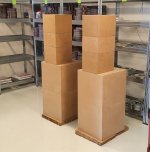Damping
Ok, so it's time to start damping the test cab's.
I have 4 different materials available at the moment.
1. Bitumen, to reduce panel resonance.
2. Felt
3. Polyester
4. Egg crate foam
My general idea is to use Bitumen first, then felt. This for both the midbass and the midrange enclosure. On all surfaces except baffle.
Then the question is...
Midbass, add both Polyester and foam? One or the other? Nothing? I have never damped a midbass enclosure before so I'm a bit lost.
Midrange I try to keep "clean". The driver is high Qm and, in lack of a better word, plays a "fast" midrange. The enclosure should not have a lot of dampening or the sound suffers. So I will try just the Bitumen and felt to start with.
Any input is highly welcome.

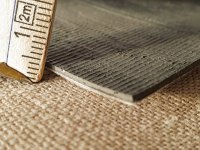
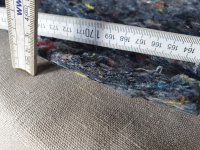
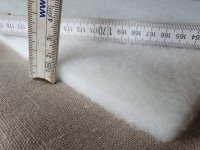

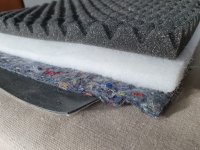
Ok, so it's time to start damping the test cab's.
I have 4 different materials available at the moment.
1. Bitumen, to reduce panel resonance.
2. Felt
3. Polyester
4. Egg crate foam
My general idea is to use Bitumen first, then felt. This for both the midbass and the midrange enclosure. On all surfaces except baffle.
Then the question is...
Midbass, add both Polyester and foam? One or the other? Nothing? I have never damped a midbass enclosure before so I'm a bit lost.
Midrange I try to keep "clean". The driver is high Qm and, in lack of a better word, plays a "fast" midrange. The enclosure should not have a lot of dampening or the sound suffers. So I will try just the Bitumen and felt to start with.
Any input is highly welcome.






I have done some experiments myself with damping and a good way to see it for yourself is to measure the impedance of the speaker in the box when you change the damping also compare that to the free air impedance curve of the driver.
Any wiggles you see in the curve that are not present in the free air curve are coming from the cabinet.
Bitumen is good for adding mass, other than making the cabinets too heavy to lift mass is usually a good thing.
Felt works quite well too.
Egg crate foam and polyester were underwhelming in my tests.
The best combination was fibreglass and felt on top. Standard fibreglass that you can buy from the hardware store. The cheaper less dense stuff works better as long as you have sufficient depth of it.
In a mid cab you are looking to absorb the backwave and reduce cabinet colouration. A layer of fibreglass or two and felt will do as good a job as anything.
In a woofer cabinet you might be trying to make the box volume appear to be bigger than it really is. In that case you stuff as much fibreglass as you can in and cover it in felt.
In any form of vented enclosure fibreglass is not so good because the fibres can escape. Less likely if covered completely in felt or with a layer of polyester in front.
Any wiggles you see in the curve that are not present in the free air curve are coming from the cabinet.
Bitumen is good for adding mass, other than making the cabinets too heavy to lift mass is usually a good thing.
Felt works quite well too.
Egg crate foam and polyester were underwhelming in my tests.
The best combination was fibreglass and felt on top. Standard fibreglass that you can buy from the hardware store. The cheaper less dense stuff works better as long as you have sufficient depth of it.
In a mid cab you are looking to absorb the backwave and reduce cabinet colouration. A layer of fibreglass or two and felt will do as good a job as anything.
In a woofer cabinet you might be trying to make the box volume appear to be bigger than it really is. In that case you stuff as much fibreglass as you can in and cover it in felt.
In any form of vented enclosure fibreglass is not so good because the fibres can escape. Less likely if covered completely in felt or with a layer of polyester in front.
Test for yourself, with only bitumen and a single layer of felt, it's likely stuff will be coming back out from places it shouldn't. Try increasing layers of felt until the sound suffers then back off 🙂Midrange I try to keep "clean". The driver is high Qm and, in lack of a better word, plays a "fast" midrange. The enclosure should not have a lot of dampening or the sound suffers. So I will try just the Bitumen and felt to start with.
Last edited:
A small update
Test cabinet stage scrapped, I went for the real cabs instead.
Seen here in raw MDF.
Height as they stand now is 150 cm (ab. 5 feet)
Test cabinet stage scrapped, I went for the real cabs instead.
Seen here in raw MDF.
An externally hosted image should be here but it was not working when we last tested it.
Height as they stand now is 150 cm (ab. 5 feet)
Well, **** happens...
This project took a turn and ended up like this.

8" & TPL-150 were replaced by a lovely horn with JBL 2446H.
Also using a MiniDSP Flex8 with Dirac.
All's well that ends well, I guess. 😉
This project took a turn and ended up like this.
8" & TPL-150 were replaced by a lovely horn with JBL 2446H.
Also using a MiniDSP Flex8 with Dirac.
All's well that ends well, I guess. 😉
So what was the final spec of the speaker system? I know there's a 2446 in there, but what horn and diaphragm?
Horn: https://horns-diy.pl/horns/jmlc/jmlc-270/
Diaphragm is original so far. Thinking about aquaplas...
Diaphragm is original so far. Thinking about aquaplas...
Well worth the inestment over the standard Ti diaphragm.Diaphragm is original so far. Thinking about aquaplas...
- Home
- Loudspeakers
- Multi-Way
- 4-way with dual 21", dual 15" & dual 8" + TPL-150. An IBWWMTM...
